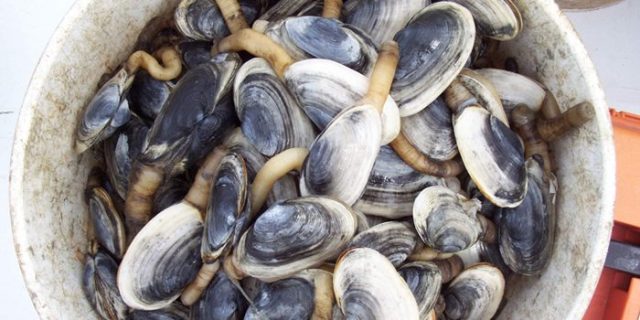04
Jan
“Silence of the Clams”—Study Highlights the Threat of Multiple Pesticide Stressors to Bivalves

(Beyond Pesticides, January 4, 2021) Chronic exposure to pesticides used in conventional forestry operations runoff and harm soft shell clams, according to a recent study published in Science of the Total Environment, entitled “The silence of the clams: Forestry registered pesticides as multiple stressors on soft-shell clams.” Rather than focusing on the impact of a single chemical, researchers analyzed the combined effects of several pesticides. “This is an important data gap to fill as research on these compounds’ toxicity typically focuses on individual compound effects at high concentrations to determine lethality, which while necessary for understanding compound toxicity, can miss sublethal effects that can have long term impacts on these systems,” said lead author Allie Tissot of Portland State University.
The soft shell clam, Mya arenaria, is found to be widespread in coastal areas in both the western and eastern U.S., and is often eaten in stews or chowders. A recent study found a range of chemical contaminants detected in Oregon populations of these species, prompting researchers to further investigate the impact of these exposures. An experiment was set up with tanks to mimic a seabed, and eight different groups of 11 clams were established and treated with various amount of pesticide over the course of 90 days. The pesticides tested included various combinations of atrazine, hexazinone, indaziflam, and bifenthrin. Every ten days, the tanks were dosed, and 30 days the clams were analyzed for their weight and growth.
Every combination of pesticide dosing resulted in higher mortality rates than control tanks where clams were not exposed to any pesticides. “These findings demonstrate that, in addition to accumulating in tissues, compounds in different combinations result in varying effects on nontarget organisms sensitive to these pesticides, even at low concentrations,” the study notes. Many of the nonlethal changes observed indicate a loss of fitness in the environment, such as elongated shells, low tissue weight, and slower rate of clearing algae from their tank with clams exposed to a combination of atrazine and hexazinone.
In addition to pesticides, ocean bivalves are contaminated with a range of human produced hazards, including pharmaceuticals, and the breakdown products of industrial cleaners and detergents. Despite the sensitivity of species that live along shorelines, and humans’ desire to eat many of these animals, environmental laws do little to stop runoff and contamination that ultimately makes it to dinner plates. In fact, pesticides are used to extract the natural wealth of these areas, resulting in contaminated clams people’s plates. In 2018, an association of Washington’s oyster growers proposed to use the hazardous neonicotinoid insecticide imidacloprid in Willapa Bay to manage shrimp populations that compete with the oysters. The effects of imidacloprid on certain aquatic organisms are wide-ranging and include significant reduction in abundance, significant reduction in survival, reduced feeding, and behavioral changes. Only after widespread public opposition did the state Department of Ecology deny this permit.
Bivalves are sentinel species, and ill effects seen in these animals are likely an indication of broader issues with the health of other benthic and shoreline creatures. Pesticide use in aquatic environments travels up and down the food chain, resulting in trophic cascades that can ultimately affect human health on a broad scale. In addition to measures that directly reduce pesticide use into waterways, regulators should evaluate ecosystem-level effects, and regulators must take steps to look at pesticide use in the context of the full range of other toxic contaminants that could be present in the environment. And if such a task is deemed too complex of an undertaking, the response should utilize precaution, and new hazardous products should not be allowed on the market without complete understanding of how it will interact with the preexisting toxic soup humans have created in far too many bodies of water.
For more information about the dangers pesticides pose to water quality and aquatic wildlife, see Beyond Pesticides Contaminated Waters program page.
All unattributed positions and opinions in this piece are those of Beyond Pesticides.
Source: Portland State University, Science of the Total Environment










